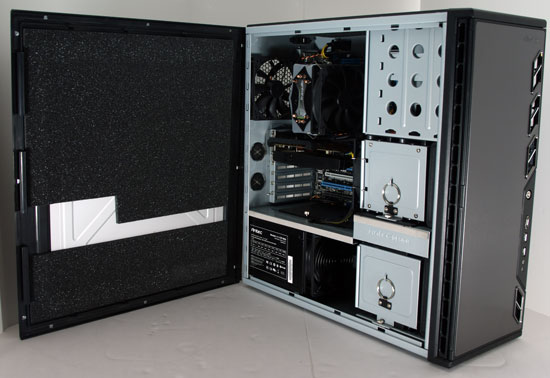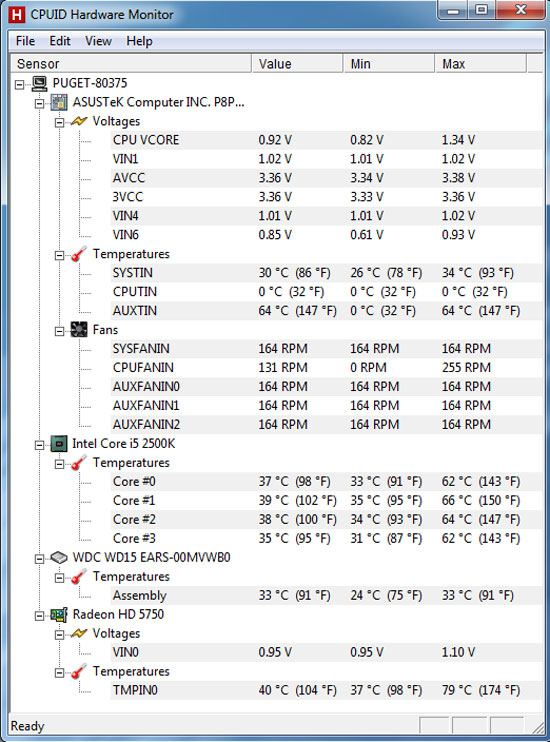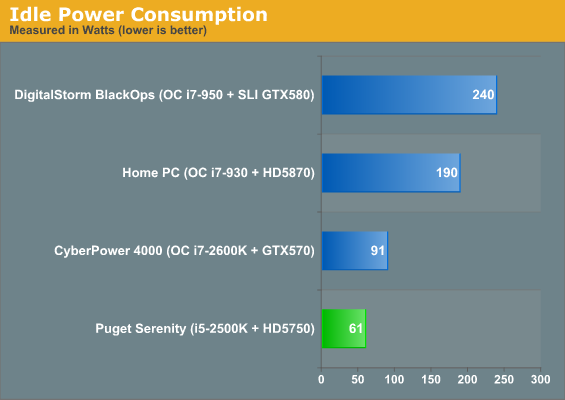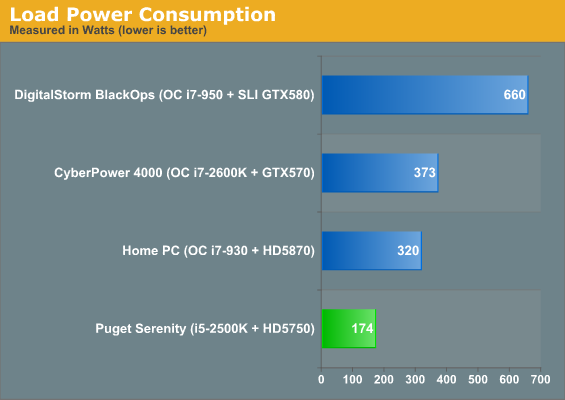Puget Systems Serenity SPCR Edition: Blissful Silence
by Dustin Sklavos on February 10, 2011 12:00 AM EST- Posted in
- Systems
- Intel
- Radeon
- Sandy Bridge
- Puget Systems
- Serenity SPCR
Build, Noise, Heat, and Power Consumption
Given the somewhat exotic nature of Puget Systems's Serenity SPCR Edition tower, it's reasonable to assume that there just aren't any good corners to cut. I'm happy to report that, having examined the system, Puget Systems simply couldn't and didn't.
What makes the build particularly interesting compared to the others is that, as I mentioned in the introduction, this really is a custom build, not just a melange of carefully chosen and assembled parts. Take a look inside and see what I mean.

Seeing the additional foam padding on the inside of the side panel when I had to remove the internal packing was a major cue, and the foam has been carefully cut to fit around the internals of the Antec P183 case used for the build. From the photo you can see three major points in Puget Systems's favor: quality case, quality power supply, and additional custom sound dampening. What's harder to see is that Puget Systems removed the Antec Tricool fans from the case and replaced them with silent Scythe 120mm fans. They've also bracketed an additional fan to the top hard drive tray, and they've removed the top exhaust fan and covered the vent with foam.
Another interesting point is the use of an air cooler instead of a watercooling system on the processor. I've reviewed more desktops with watercoolers than not and they're generally considered among the quietest ways to go, but here Puget Systems opts to use an air cooler—the Gelid Tranquilo—with a silent fan. They also carefully tuned the fan speeds in the ASUS board's UEFI to ensure silent running.
Certainly building the entire system for low noise is going to mean running a little hotter than normal, though, right? Interestingly, that's not the case.

Check out those thermals. The Serenity SPCR Edition keeps everything running remarkably frosty, and that's due in no small part to the attention paid to airflow inside the case. The P183 was already an excellent case with great thermals (we actually have a review unit on hand and we'll be posting a case review in the coming months), but the modified cooling produces airflow moving in effectively a straight line through the tower with minimal turbulence, allowing the fans to run at low speeds without compromising thermal performance. Even the Radeon doesn't crack 80C.
With those temperatures and the system's configuration in mind, these power consumption figures should come as no surprise to you:


We tested power consumption by idling at the desktop, and then running our Left 4 Dead 2 timedemo. In my experience, very few games are capable of pulling as much power from a system as Left 4 Dead 2 can. Something about the Source engine's relatively frugal usage of graphics hardware lets the processor and video power consumption scale well together.
Under load, Puget Systems's Serenity SPCR Edition draws less power than my fairly frugal desktop does at idle. Sandy Bridge has proven to be stunningly power efficient in the testing we've been able to do (we really can't wait to get our hands on more Sandy Bridge-equipped notebooks), and combining that with the already efficient Radeon HD 5750 keeps power consumption low. The next system up on the list—my home tower—draws nearly twice as much power under load. That increase in power draw may be commensurate with the increase in gaming performance, but keep in mind the i5-2500K is able to handle processor-intensive tasks much more efficiently than the i7-930.
















139 Comments
View All Comments
flemeister - Thursday, February 10, 2011 - link
"why did they pick a 850W PSU?"They didn't pick the CP-850 because of it's 850W rating, they picked it because it's the most suitable for the job:
1) It's exceptionally quiet
2) It's pretty cheap for the wattage on offer
3) With no fan in the front of the HDD/PSU chamber for the sake of silence, the 120mm fan on the CP-850 provides cooling for hard drives in the lower drive cage
4) Most important of all, the fan only ramps up from its minimum speed after reaching ~300W load (in a hotbox; ~400W if it's intaking cooler air, such as when installed in the lower chamber of the P183). With such low power consumption in this setup, the PSU fan will never ramp up. Even with Crossfired 5750's, max power consumption will have trouble going past 300W.
5) What are the alternatives? Something else this quiet would cost a similar amount and be just as quiet or perhaps noisier. May as well use the CP-850.
See the SPCR review of the unit for more details.
michal1980 - Thursday, February 10, 2011 - link
I read the spcr reviews. Bla bla bla. A smaller PSU, picked for the correct energy usage, is whats needed. This isn't engineering, this is over kill.There are fanless psu's outthere if you are going for ie from the spcr site itself
Seasonic X-400. Game,set,match. No fan, will go up to 400watts. Whats Puget excuse?
Oh you need a fan for the hd? waa waa, hook up another super low rpm fans on a control. Idleing, have them turn off.
P.S.
Whats the excuse for the subpar gaming perfomrance, that anandtech seems to be whitewashing over?
Anchen - Thursday, February 10, 2011 - link
http://www.newegg.com/Product/Product.aspx?Item=N8...http://www.newegg.com/Product/Product.aspx?Item=N8...
Hey, which is cheaper? The antec 850, NOT the seasonic x-400. Game set match? The Seasonic x-400 is an awesome psu. It also costs a ton for 400w. Seems like a good excuse to me.
michal1980 - Thursday, February 10, 2011 - link
wow, the 850w psu is 7 dollars cheaper OMG, (850w= 119+12ship, 400w 129+6ship)This is a $2,000+ thats claiming to be designed for silence, and they cannot eat a ~$10 difference? Or just rise the price 10 bucks? And claim its even more silent?
The point is to use the right tool for the job, just throwing something bigger at a problem is dumb engineering.
Sagrim - Thursday, February 10, 2011 - link
It'd come out to around an extra $20 if you include the extra fan that would be needed for the lower cage/psu area. Which, would require the fan to be upfront near the case (notice, ZERO intake fans are at the front) -- which would most likely up the dB slightly (even at low).Also, the x-400 would leave little wiggle room in terms of upgrading the gpu, and/or overclocking (notice, it was the K series).
So, the Antec CP-850 provides the wind tunnel effect down below with it's "pass through" design, it's cheaper, it is stunningly quiet, and helps the overall airflow/cooling of the system.
I fail to see the need for the x-400, even if the CP-850 is considered overkill.
Taft12 - Thursday, February 10, 2011 - link
There you go bringing ACTUAL engineering into a newbie's rant against "dumb engineering".We're trying to keep things dumb around here! You're ruining it!
michal1980 - Thursday, February 10, 2011 - link
I've been on anandtech for years before you joined. And years before I even regesitered.As an engineer, I see dumb engineering.
smart engineering would be to go with a passive psu, that with a seperate fan. Dumb engineering to go bigger to solve the problem.
mino - Thursday, February 10, 2011 - link
Go for a beer and come back when you manage to process Sagrim's post.Thank you.
kmmatney - Friday, February 11, 2011 - link
Why would you want such as low-powered PSU? The 850W allows for upgrading components in the future - seems like a great choice.michal1980 - Friday, February 11, 2011 - link
because 400watts is more then enough for even a high power video card.Look back at anandtech gpu reviews.
single 6970 tops out at ~360 watts.
I love the more is better mentallity.
A direct result of stupidty, and a direct cause of waste.